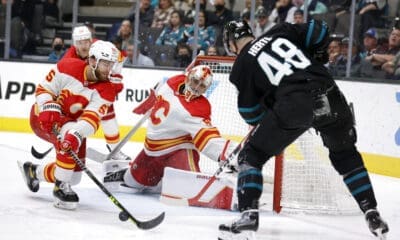Calgary Flames
Signing Bouwmeester – Pros and Cons

I’m guardedly excited about the possibility of adding Jay Bouwmeester to the Flames roster. My reluctance comes from his potential sticker price and the Flames looming cap issues, not my perceptions of him as a player. As I’ll try to illustrate, Bouwmeester is probably one of the best defenders in the game currently.
Why the Flames should sign him
It's easy to look at Bouwmeester's offensive output weighed against his high sticker price and not be impressed. After all, this is a player that has only scored more than 45 points in a season once, despite frequently being a top 5 guy in terms of ice-time. His ESP/60 rate last season was just above middling (0.71/60) and his -2 was despite a .936 ES SV%.
One has to consider Bouwmeester’s surroundings and circumstances when looking at his results, however. His Quality of Comp rating last season was +0.07, meaning he routinely plays against the best opposition available. In addition, Bouwmeester was on the ice for a staggering 576 defensive zone draws last year, a full 180 above the 396 offensive zone face-offs he saw at ES. To put that in perspective, Dion Phaneuf was +129 in terms of OFF-DEF draws, while Robyn Regehr – Calgary’s primary tough minutes defender – was -4. In a recent post on face-off ratios, Tyler Dellow noted
In the thirty seconds following offensive zone faceoffs, the Oilers were dominant, outshooting the opposition 217-121 and outscoring them 18-10. After defensive zone faceoffs, they were the flip side, getting outshot 315-161 and outscored 26-16. There’s still a marked edge after 45 seconds, which is basically an entire shift. One’s like being the best team in the NHL, the other is like being the worst.
Assuming that this is in some way typical of NHL teams as a whole and that’s its not an effect created by lousier players tending to get the defensive draws – I would think that it is typical and that offensive and defensive zone draws are spread widely enough – then guys who are taking a lot of defensive zone faceoffs are going to be taking a bit of a hit on their numbers, whereas guys who start a disproportionate amount of time at the other end of the ice are going to look better than they otherwise are.
How big of an effect are we talking about? Tough to say. The numbers I’ve assembled say that the Oilers and their opposition were taking about 29.3 ESS/60 in the 45 seconds after taking an offensive zone faceoff and allowing about 18.6 ESS/60. Now, sometimes there would be situations where you’ve got multiple faceoffs in a 45 second span, which will drive my numbers down, but there does appear to be a substantial effect. If you figure a .920 save percentage, you can probably figure on something like 2.4 ESGF/60 and 1.5 ESGA/60 as the expected outcome in the 45 seconds following an offensive zone faceoff, with the reverse being true when you start with a defensive zone faceoff.
Bouwmeester has been swimming with the Sharks – for years, on a crappy team – and keeping his head above water. He’s a legitimate shut-down defenseman and he can score at a decent rate while doing it to boot. If his circumstances improve on the Flames – and there’s little reason to think they won’t – his output will no doubt improve, perhaps markedly.
In addition, Jay Bouwmeester could become something of "Dion Phaneuf insurance" going foward. Let me explain –
in some ways, Bouwmeester is the player the Flames envisioned Phaneuf becoming when they signed him for six and half per year last summer. Perhaps not necessarily in terms playing style, but certainly in terms of overall effectiveness. Bouwmeester plays a ton, scores fairly regularly and, most importantly, takes on the big boys every night. Phaneuf has items 1 and 2 under his belt, but still hasn't secured skill #3. And in order for him to be value for that contract, that's a step he has to take.
After his disappointing season this year under Keenan, there's some suggestion that Phaneuf may never be able to capably fill a tough minutes roll on the back-end. Enter: Jay Bouwmeester. About the same age, about the same price, but already a proven asset in the defensive zone. If Phaneuf fails to develop further and continues his trip down the "Jovo road", Bouwmeester puts them in a much better position to deal Dion for parts in the future.
Why signing Bouwmeester is worrisome
As Robert pointed out below, it's all about cap space and budget structure. Calgary already has numerous big contracts on long term deals, including iginla (7M/year), Phaneuf (6.5M/year), Kipper (5.833M/year), Regehr (4.02/year) and Langkow (4.5M/year), the Flames organization is fast approaching a critical mass of "star contracts", especially with the cap set to stagnate/drop in the future. Adding another 6M+ to the mix would make the club hideously top heavy and dependent on a lot of low payed, high value players to fill out the spaces. And last time I checked, the organization isn't waist deep in those types of guys (read: elite rookies playing through their entry-level deals).
The Vandermeer trade was a step in the right direction, but a Bouwmeester signing would be mean Sutter would have to get even more ruthless when it comes to assessing players and dollars. Anyone at replacement level can't be making more than $1M (Primeau). Anyone whose contracts are based on a peak level that was attained years ago should be fair game (Kiprusoff, Jokinen). Finally, the org would have to be willing to move ANY of the current big dollar guys at some future point should cap flexibility become a concern. Those relatively low value deals for veteran players at the periphery of the roster that Darryl has been so fond of over the years (Amonte, Zyuzin, Eriksson, Friesen, etc)? They'd have to go away for good. The team would have to commit to aggressively promoting talent from within the org's stables and hoping the kids can become a strong enough supporting filament between the big names for the team to succeed.
It's a gamble on a number of levels. Given the quality of the player, however, it may still be a worthwhile one to take.
by Kent Wilson








